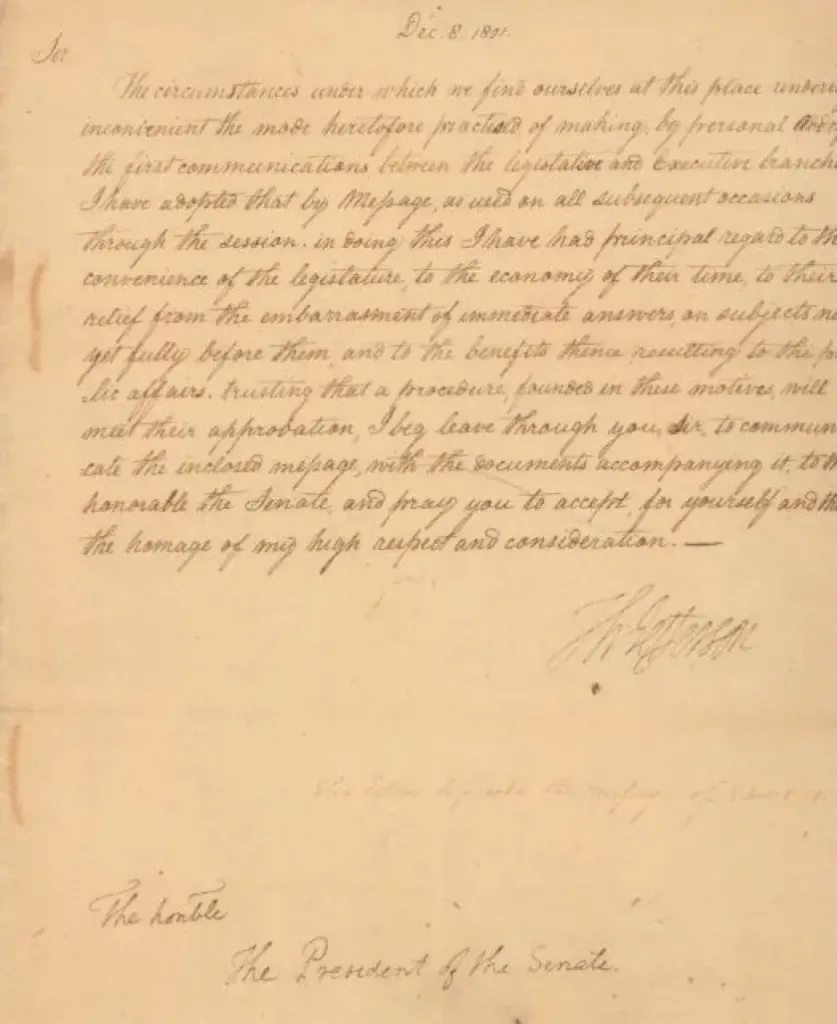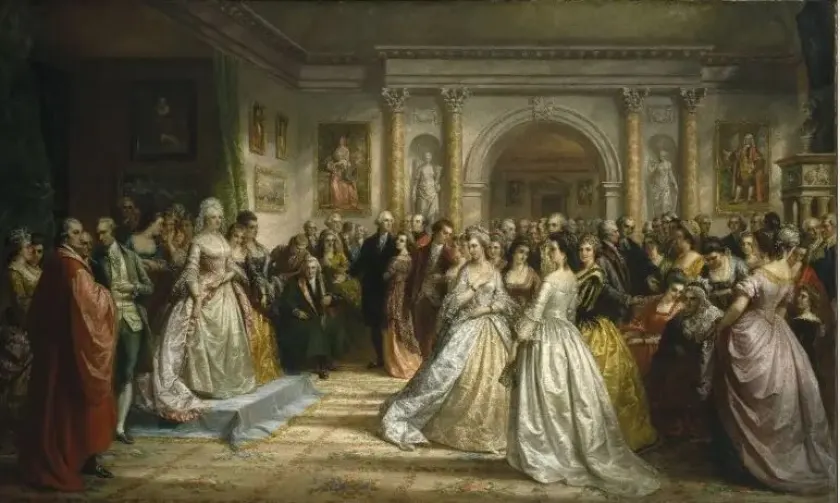And so the annual circus continues, and we have slipped another rung. The 2023 State of the Union Address Tuesday night was marred by heckling, and what’s left of our republican norms is slipping between our fingers.
If Jefferson Was President Today, He Would Have Made It an Email
The first two presidents, George Washington and John Adams, delivered their State of the Union messages in person before a joint session of Congress, but the third president, Thomas Jefferson, refused to follow their brief but powerful precedent.

It could have been an email. President Thomas Jefferson’s letter to the President of the Senate regarding the annual message, December 8, 1801. (National Archives)
The Founding Fathers were defining the new republic as they went along. How should a president comport himself? He couldn’t be a king—we had just repudiated that model with fire and sword—but what sorts of rituals and protocols would give him the aura and stature he needed to preside effectively over the new nation? Both Adams and Washington had something of a monarchical cast, at least by Jefferson’s standards. They both believed that the presidency should be characterized by a formality and a loftiness that set it apart from routine political activities.
The U.S. Constitution is silent on many questions. There is no mention of a cabinet, no mention or accommodation of political parties, and no requirement that the president appear once a year before Congress to assess the national experiment and propose measures to be taken up by Congress.
Both George Washington and John Adams wore ceremonial swords on important occasions. That perhaps made sense with Washington (“first in war…”), but John Adams never once fired a gun in combat. Most of his compatriots thought he looked ridiculous. President Washington refused to shake hands with the American people. At his weekly levees—another habit borrowed from European monarchies—Washington moved slowly around the room (everyone had to stand) and bowed stiffly to his “subjects.” When, in a bet, his very close friend Gouverneur Morris presumed to touch the president lightly on the shoulder, Washington turned to him, gave him the “blue glare” treatment, and removed Morris’ hand from his executive person.

George Washington’s levees were stiffly formal, Martha’s receptions were more sociable. At his Tuesday levees, the president did not shake hands but rather received guests with a formal bow; he wore a black velvet suit with a white vest and yellow gloves, breeches, silver knee and shoe buckles, and carried a ceremonial sword and cocked hat. By contrast, at Martha’s receptions, the president presented himself as a “private gentleman,” dressed more plainly, and conversed freely, especially with the women. (mountvernon.org)
Adams was so sure our republican form of government would not have sufficient gravitas without artificial props that he proposed to the Senate that we adopt titles of nobility for our national officers, particularly the president. Adams offered some possibilities: “His Elective Majesty,” “His Mightiness,” and “His Highness, the President of the United States of America and the Protector of their Liberties.” Because of this nonsense, the wits of Congress soon gave Adams, who was short and portly, his own titles: “His Rotundity,” “The Duke of Braintree.”
A True “Republican” President
Thomas Jefferson believed in the idea of a republic perhaps more than any other figure of his time. He believed the people were sovereign and they were up to the challenge of governing themselves. He thought of the president of the United States as a kind of chief administrative officer, the “first farmer,” mild and dutiful, selflessly doing the nation’s business for a short period of time, and then retiring back into the greater happiness of private life. He wanted the United States to avoid all trappings of monarchy, majesty, aristocracy and public ceremony.
That’s why he walked to his inauguration on March 4, 1801. That’s why he greeted guests at the White House in his slippers. That’s why during his eight years as president he rode his horse around the nation’s capital without security, often doing some of the grocery shopping himself for his famous afternoon dinner parties. And that’s why Jefferson broke with the habit of his two predecessors and sent his annual message up to Congress by courier. This would indicate our distaste for pomp and circumstance, he said, would declare emphatically that we did not want even a watered-down monarchy, and it would save two weeks of congressional time.
And There We Are Stuck
The modest precedent that Jefferson set in 1801 took root in American political life. All the presidents between Jefferson (the third) and Woodrow Wilson (the 28th) sent their annual messages up to Congress by courier. For reasons that are not entirely clear, Wilson decided to deliver his address in person in 1913. And there we are stuck. It’s hard to imagine even the most humble president (Jimmy Carter, Gerald Ford) now foregoing the opportunity to strut and wink and hug and brag and hold forth for a couple of hours once a year on prime-time television with a captive audience of the most powerful people in America. Media has only exacerbated the problem. The first national radio broadcast of the State of the Union address was delivered by Calvin Coolidge in 1923. Harry S. Truman delivered the first televised address in 1947. And President Lyndon B. Johnson delivered the first prime-time television State of the Union address in 1965.
And Bill Clinton gave the first State of the Union message streamed on the Internet.
It is one of history’s ironies that Wilson took the congressional stage in 1913, four years after the retirement of his great predecessor Theodore Roosevelt. How Roosevelt would have loved having the opportunity to show off his skills as a writer and an orator before a joint session. Roosevelt had the personal charisma and capacity to lean into a hesitant congressman we associate with LBJ. He loved power. He loved to play his power out before an audience, even a hostile one. He took enormous delight in working a crowd, gesticulating wildly, pounding his right fist into his left hand, leaning over the railing until you worried he might fall, working himself up to falsetto on the great points, telling anecdotes of his cowboy years in Dakota Territory, talking the Big Stick. Contemporaries said he seemed to bite off his words with his oversized teeth, so that you could actually hear them clicking when he got worked up.
The in-person State of the Union address was made for TR. He might have kicked himself in December 1913 when a man he regarded as unfit for the presidency took the podium, but while “professor” Wilson, a man he derisively called “that Byzantine logothete” gave the first modern State of the Union speech, TR was beginning his last great adventure, his near-fatal exploration of the River of Doubt down in the Amazon basin.
The Loss of Civility in America
Until quite recently, even in-person State of the Union addresses were somber. Members of Congress, the Supreme Court, the Joint Chiefs of Staff, the cabinet and others sat quietly in the chamber and listened with attention and great civility to the president. Applause was not uncommon, but back then it felt more like the applause you’d see at a symphony concert than at a football game. Everyone involved understood that this was an important annual moment of civic engagement, a ritual of national unity, and that the man at the podium was the president of all of the people of the United States, not just those who voted for him. As we all know, however, in recent years the general level of civility and decorum has spiraled downward all over America in almost every arena, including at times church services. The old notion that we owe the office of the presidency our respect even if we don’t much like the current occupant is now regarded as quaint and naïve, like holding your little finger out while sipping a cup of tea.
Things began to change during the presidency of Ronald Reagan and came to a head with the coming of Barack Obama. On the one hand, gimmicks and tropes of the kind you would expect to see on Real Housewives reality TV. On the other, increasingly unruly congressmen and women willing to damage American norms by disrupting the president’s speech.
On Jan. 26, 1982, our first “media” president, Ronald Reagan created a new tradition when he singled out a man named Lenny Skutnik, up in the balcony, the U.S. government employee who dove into the icy Potomac River to save a woman after a commercial airplane crash.
Since then every president has placed some exemplary American or group of Americans in the balcony, next to the first lady, to be honored as a victim or a survivor or an everyday hero. At its best this small club of more than 100 Americans has included Rosa Parks (1999) or Jim Brady (1994), who suffered a grievous head injury during the assassination attempt on President Reagan in 1981, but it has also included a kid whose high school science experiment was lost in the space shuttle Challenger disaster, and a Pennsylvania woman whom President G.W. Bush cited as someone who would benefit from his proposed tax cuts.
That said, the current president’s respectful and impassioned words of support to the parents of Tyre Nichols on Tuesday night were deeply moving and received the whole body’s endorsement.
And Now the Disrupters and the Hecklers
In 2009 Rep. Joe Wilson of South Carolina shouted out “You lie!” when President Obama was explaining details of his Affordable Care Act. Criticized by both Republicans and Democrats, Rep. Wilson later apologized personally to Obama.
On Feb. 4, 2020, Speaker of the House Nancy Pelosi ostentatiously tore up her copy President Trump’s State of the Union speech on national television. She justified this breach of basic civility—he was the duly-elected president of the United States—with a Tweet.
In 2022, Lauren Boebert, a Colorado Republican, heckled President Biden when he was talking about America service members killed during the U.S. withdrawal from Afghanistan in August 2021. Boebert stood up in the House chamber and loudly accused the president of wantonly sacrificing the lives of American service members at the airport in Kabul. Then Boebert and Georgia Rep. Marjorie Taylor Greene attempted to start a “build the wall” chant when the president was talking about border issues. Neither of them apologized. Boebert, in fact, said she would be happy to do it again next time.
This year, chamber microphones picked up a heckler’s chants of “bull—t.” For her part, Taylor Greene yelled “liar” nine times during the address.
It now seems that no State of the Union address is immune to some sort of breach of decorum and civility. The cameras in the chamber often focus on adversaries of the administration. The whole circus feels more and more like something that you’d witness in the late Roman Empire. Social commentator Jacob Bacharach has written, “In recent years, thanks to the increasingly commingled worlds of politics and popular entertainment, the annual State of the Union address has evolved into an even grander and creakier spectacle: a nationally broadcast circus of government whose uncanny resemblance to an awards show or grand fund-raising gala has only grown as its cast of characters expanded.”
Does anyone think we have reached bottom yet? Remember, the House just voted to remove the magnetometers that have kept firearms out of the chambers for the last two tumultuous years.
Republished with permission from Governing Magazine, by Clay S. Jenkinson

Governing
Governing: The Future of States and Localities takes on the question of what state and local government looks like in a world of rapidly advancing technology. Governing is a resource for elected and appointed officials and other public leaders who are looking for smart insights and a forum to better understand and manage through this era of change.
